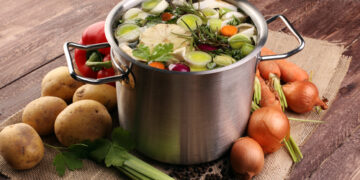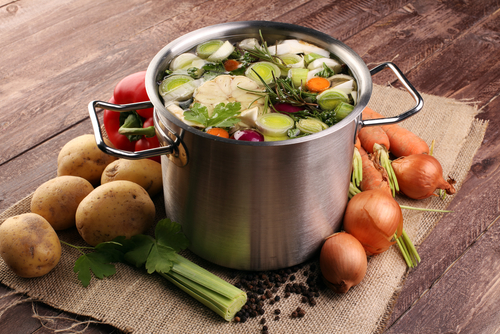The Beginning of Everything
In any healing kitchen, the first thing you learn to make is broth. Not because it’s trendy, not because it’s fast, but because everything depends on it. You can’t build flavor without it. You can’t nourish deeply without it. And once you’ve tasted your own—rich with herbs, roots, scraps, and time—you never go back to cartons again.
Vegetable broth is slow magic. It’s transformation. The process of taking what would usually be discarded—peels, skins, stalks—and drawing out everything they have left to give. When done well, it becomes more than a base. It becomes warmth, grounding, a source of minerals and depth you can return to all week long.
The broth below is one I make almost every Sunday. Sometimes in the background while I clean or fold laundry. Sometimes with more intention, stirring slowly, windows open, herbs from the garden. It’s flexible, seasonal, but always nourishing.
Healing Mineral-Rich Vegetable Broth
A slow, grounding broth that forms the base of soups, sauces, grains—or is beautiful on its own in a mug.
Ingredients (makes ~2 quarts):
-
1 large yellow onion, quartered (skins on)
-
2 medium carrots, chopped
-
2 celery stalks with leaves, chopped
-
1 leek, green tops included, sliced and rinsed
-
3 cloves garlic, smashed (skins on)
-
4–5 fresh parsley stems
-
1 tsp black peppercorns
-
1 small strip kombu (optional, for added minerals and umami)
-
2 dried shiitake mushrooms (or stems from fresh mushrooms)
-
1 bay leaf
-
1 tbsp apple cider vinegar (helps pull minerals from the vegetables)
-
10 cups filtered water
Instructions:
-
Place all vegetables, herbs, kombu, and mushrooms into a large stock pot.
-
Pour in the filtered water and add the apple cider vinegar.
-
Bring the pot to a gentle simmer over medium-high heat. Once it starts to bubble, reduce the heat to low.
-
Simmer uncovered or partially covered for 2 to 3 hours, checking occasionally and adding more water if needed.
-
When done, strain through a fine-mesh sieve or cheesecloth. Press down lightly on the vegetables to extract every last drop.
-
Let cool, then transfer to glass jars. Store in the refrigerator for up to 5 days, or freeze for up to 3 months.
A Few Notes on Ingredient Choices
Every ingredient in this broth serves a purpose—nutritionally and energetically.
Onions and garlic bring immunity and gut support. Their skins add color and subtle complexity.
Carrots lend a natural sweetness and are rich in beta-carotene.
Celery and leek provide the kind of aromatic base that makes soups feel whole.
Kombu and mushrooms infuse the broth with deep umami and trace minerals like iodine and selenium.
Herbs and bay leaf bring not just flavor but a quiet energy—cooling, grounding, stabilizing.
The apple cider vinegar is small but powerful. It helps extract calcium, magnesium, and potassium from the vegetables during the long simmer.
Seasonal Variations
Use what’s abundant and appropriate for the time of year. Broth is a seasonal act—it reflects what’s growing, what’s dying back, and what the body needs.
In spring: add fennel tops, green garlic, parsley roots
In summer: corn cobs, basil stems, zucchini ends
In autumn: parsnip, fresh thyme, mushroom caps and stems
In winter: rosemary, cabbage cores, sweet potato peels
Let the garden or the market inform what you use. There’s no wrong combination when the ingredients are real and whole.
How to Use Your Broth
Once you’ve made your broth, the possibilities open wide. This is your kitchen’s foundation—ready to build something nourishing and alive.
Here are just a few ways to work it into your week:
-
Warm sipping broth: heat a cup on the stove with a splash of olive oil, a pinch of sea salt, and some fresh herbs. Sip instead of tea when you feel under the weather or overextended.
-
Grain cooking liquid: use in place of water for quinoa, brown rice, millet, or farro. It adds a richness that transforms even the simplest bowl.
-
Soup base: build lentil stews, miso soups, or pureed root soups over this base and taste the difference.
-
Braised vegetables or beans: add broth to your sauté pan when cooking kale, cabbage, or beans to infuse them with deep flavor.
-
Sauce and reduction base: reduce the broth by half with fresh herbs and a splash of vinegar for a quick, light sauce over roasted vegetables or fish.
A Kitchen That Heals
Making broth is one of the simplest acts of care you can offer yourself and your home. It’s not glamorous. It’s not immediate. But it builds something bigger—a kind of foundation for the rest of your week.
When you start with broth, everything tastes more alive. Everything sits easier in the belly. And the act of making it—gathering scraps, simmering slow, straining and storing—becomes a ritual that nourishes far beyond the cup.
In a culture that rushes to consume, broth asks you to slow down. To let things steep. To believe that what’s discarded still has value. That time and heat can bring out the best in what was nearly forgotten.
That, to me, is the essence of healing cuisine.



























